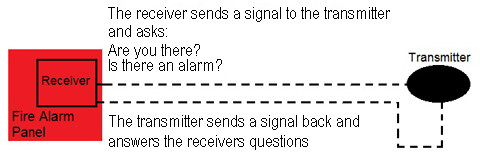Wireless Fire Alarm Systems
Introduction
It seems as if wireless technology has been around for years. But, within the fire and security industry it is a relatively new concept. It has only been in the last ten years that wireless alarm panels and devices have been on the market. There have been huge advances in this sector over the years. At the beginning of this movement, devices were powered by simple AA or 9 volt batteries; that would have to be replaced often. Now however, devices are powered by lithium batteries and have a longer lifespan. At one point manufactures were producing devices that operated at a 900MHz frequency. They soon needed to change this frequency because many other devices (telephones, garage door openers) were being produced and the alarm devices were causing interference.
This article will describe the following:
• Wireless Technology Theory
• Wireless Fire Alarm Devices and their Operation
• Location of Fire Alarm Panel and Devices
Wireless Technology Theory
The following diagram is a very simple explanation of wireless technology.
Figure 1- How wireless fire alarms operate

In order to for a wireless system to function, two parts are required:
• Receiver
• Transmitter
Receiver
The receiver is a circuit board that utilizes a coil/antenna to communicate. It operates at a designated frequency and is the “brains” behind the entire wireless system. Its job is to send out information to the transmitters and decipher the information being received.
Transmitter
A transmitter is any device that communicates with the receiver. Transmitters come in many different forms. They also have a coil/antenna and communicate at the same frequency as the receiver. Each transmitter has a particular ESN (Electronic Serial Number), that the receiver understands and uses to communicate with the transmitters on the system.
Wireless Fire Alarm Devices
A wireless fire alarm system consists of the following common transmitters/devices:
• Smoke Detector
• Universal Wireless Transmitter
• Keypad
• Communicator
Smoke Detector
Simply put, a smoke detector is a device that detects smoke. There are two main types of smoke detectors that are used today, photoelectric or ionization. Due to its superior false alarm prevention, the most common type is the optical (photoelectric) smoke detector. Wireless smoke detectors utilize this form of detection. As mentioned earlier, this device is powered by lithium batteries; the lifespan of which is generally, approximately five years.
Photoelectric smoke detectors use light to detect smoke. A smoke detector consists of three main parts; a light, usually an LED (light emitting diode), a lens and a photodiode or other photo electric sensor. The LED emits light, which is then gathered by the lens to form a beam and this beam is directed towards the sensor. When there is no smoke in the chamber the sensor “sees” the light. However, when smoke enters the chamber the light refracts off of the smoke particles and is no longer directed towards the beam; in this case an alarm will be indicated.
Diagram A

Universal Wireless Transmitter
Unfortunately, there is not an abundance of wireless fire alarm devices currently being produced. Heat detectors and flame sensors fall into this category; hence the reason why the universal transmitter was created. Most universal transmitters utilize two or more hardwired inputs that have their own unique ESN. Essentially a heat detector or other device can be hardwired to the transmitter and it will function.
Diagram B

Keypad
Wireless keypads are used to acknowledge an alarm condition, ascertain where an alarm has occurred, cancel a false alarm or determine whether there is a loss communication between the receiver and any of the transmitters on the system. Each keypad has a unique ESN and is powered by lithium batteries. Typically, keypads have a lighted LCD or LED screen.
Communicator
A wireless communicator is not truly a wireless device. It is usually wired to a main alarm panel either by actual wire or it is manufactured into the main circuit board. It does however communicate to a central station using wireless technology but it does not communicate with the panel’s receiver as the other afore mentioned devices do. Basically, this device transmits alarm information to a central station using a cell network. It operates like a cell phone but it sends strings of information instead of voice.
Location
Typically, wireless systems are installed in locations where it is difficult to get wire; usually an existing home, where the basement is dry walled. It is very important to note the manufacturer’s specifications when installing wireless devices.
The following is a list of details to remember when installing wireless devices:
•They must not be mounted in metal buildings. The metal will
cause interference and render the system utterly useless.
• All devices must be tested in their designated locations to
ensure they are functioning
• Fire devices must be located in central areas
• Devices should not be mounted greater than 800ft from the
receiver (this will vary depending on the manufacturer).